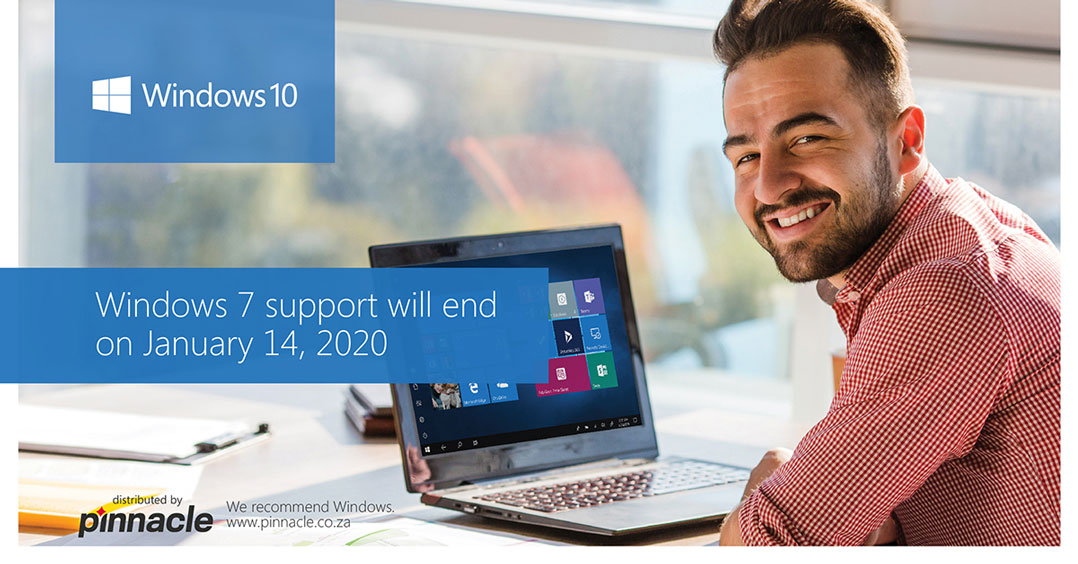 Users of Windows 7 need to be aware that support for this operating system is ending — and sooner than they might think. On 14 January 2020, Microsoft will no longer update or support Windows 7, and it will become more and more unsafe to use.
Users of Windows 7 need to be aware that support for this operating system is ending — and sooner than they might think. On 14 January 2020, Microsoft will no longer update or support Windows 7, and it will become more and more unsafe to use.
“Unfortunately, although Windows 7 is more than 10 years old, having been introduced in July 2009, it is still surprisingly popular, with research claiming it is still being used on nearly 40% of all PCs,” says Anandi Hartzenberg, Microsoft brand executive at Pinnacle, South Africa’s leading ICT distributor.
“All versions of Windows reach their end of life at some point. The biggest issue with remaining on Windows 7 is that no patches will be released for new malware or security issues once support has ended. This will leave users highly vulnerable to any emerging threats. We only need to look back a couple of years to realise just how dangerous using unsupported operating systems can be,” she says.
“Remember the notorious WannaCry ransomware that brought some of the world’s largest organisations to their knees in 2017? Well, this scourge targeted users that were using Windows systems that were past their shelf life. WannaCry affected around 200 000 PCs across 150 countries, with damages in the billions of dollars.”
According to Hartzenberg, mainstream support for Windows 7 ended in 2015, but the operating system received extended support, and security updates were still released by Microsoft. “That ends in January 2020 — for good.
“Businesses have the option of paying for ongoing Windows 7 support, but consumers don’t have that option, meaning the only choices available to them are: switching to a new operating system, as using an unsupported operating system which will become inevitably insecure and more buggy, or upgrading to a modern device with Windows 10. We strongly recommend the latter.”
‘No time like the present’
There is still time to review all your options. “While Windows 7 won’t suddenly stop working in January, there’s no time like the present to upgrade, particularly when it comes to securing your information and reducing risk.”
Windows 10 comes with a slew of new and exciting features, too, she says. “First is flexibility. While users complained that Windows 8 wasn’t inherently easy to use or flexible, there are no such issues with Windows 10 — it’s the best Windows that keeps getting better. It incorporates a set of features designed to boost security on mobile devices and offers a more intuitive approach to using technology. In this way, users can expect an operating system that is more agile and up to date, allowing any new security threats to be dealt with quickly,” adds Hartzenberg.
The introduction of virtual desktops is another great feature, she says. “For users who keep a lot of applications open at once or use their machines for a variety of disparate tasks, this is an excellent way to remain organised. Virtual desktops enable users to create multiple, separate desktops, each of which can display different open windows and applications.”
 There are also new keyboard shortcuts, which make life a lot easier for those of us whose work revolves around sitting behind a computer most of the day. “The newly introduced shortcuts cover a variety of things, including task view, switching to recent windows, creating, closing, or switching between virtual desktops, and many more,” she explains.
There are also new keyboard shortcuts, which make life a lot easier for those of us whose work revolves around sitting behind a computer most of the day. “The newly introduced shortcuts cover a variety of things, including task view, switching to recent windows, creating, closing, or switching between virtual desktops, and many more,” she explains.
Another great benefit is that Windows 10 has finally introduced scheduled restarts, she adds. “There will be no more annoying system updates that interrupt users while they are working or prevent them from using their system before updates are installed. Through the settings menu, users can now choose a restart time that suits them.”
Time for a sleek new modern device?
Hartzenberg adds a caution: “While upgrading to Windows 10 is the obvious choice, for those running older hardware, it might not work as well as it needs to. Microsoft has done its best to allow the operating system to run on older machines, but they might struggle. For those whose machines don’t meet the minimum specifications for Windows 10, investing in a new laptop or PC is the ideal way forward. While it will run on less powerful machines, we don’t recommend using Windows 10 on machines without a minimum of a 2GHz dual-core processor, 4GB or more of RAM and a 160GB hard drive, as it simply won’t run effectively.”
“Upgrade to a new modern device with Windows 10 from Pinnacle with a variety of top brands and options to choose from. This will make switching over and moving files and folders child’s play,” she says.
“Although Windows 7 will continue to work after 14 January next year everyone from business to consumers should start planning to upgrade to Windows 10 as soon as possible. This will alleviate any security issues or a loss of productivity,” she concludes.
- This promoted content was paid for by the party concerned




